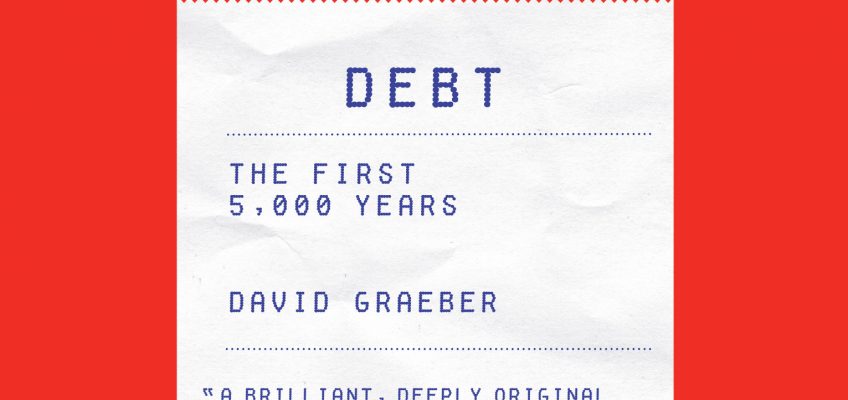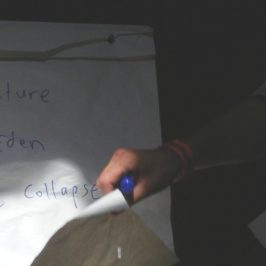This review of David Graeber’s ‘Debt’ appeared in Volume 16 of the International Journal for Community Currency Research. It was difficult to really communicate the depth and breadth of this book in the space available but hopefully it will whet your appetite for a book which is bound to change the way you think about money, debt and society. If you haven’t already gobbled it up.
About a year after its publication ‘Debt – The First 5,000 Years’ has already attained status as a landmark piece of scholarship on the nature of debt and money. It has received widespread attention across the blogosphere as well as in academic debates about money in economic theory. Graeber’s achievement is a highly readable and thought provoking re-writing of monetary history, which has the potential to change the reader’s understanding of debt as a moral concept, economics, and the role of debt-based money in the development of states, markets and capitalism.
The basic question asked in ‘Debt’ is how a promise or social obligation turns into debt resulting in behaviour that would otherwise be considered immoral. The short answer is violence and moral perversion; Graeber argues that whereas a favour cannot be calculated, debt is precisely calculation of equivalence between disparate objects and, historically, of people. Only by severing humans from their unique social contexts can they be given a monetary value and treated as identical to something else. Anchoring his argument in rich historical evidence going back to the first societies where use of money is found, Graeber shows how this has played out in civilisations from Mesopotamia and Imperial China to Greece and the capitalist empires.
Taking us on a journey through a broad array of cultural and historical conceptions of money, Graeber succeeds in turning conventional wisdom in monetary theory on its head. And what he achieves on this journey is not only substantiating that, historically speaking, goods almost always changed hands using credit (disproving the ‘myth of barter’ which is central to classical economic theory), he also shows how some of our core philosophical and political assumptions about civilisation are based on myths about debt and money which simply do not hold in the light of evidence. Opening up for a re-examination of human motivation, the conception of freedom and the relation between states and markets, it is not inconceivable that this book has the potential to transform the discipline of economics itself.
The book makes several points which I think are of particular interest to readers of this journal. First of all, the implications of dispelling the standard narrative of “from barter to money to credit” are far ranging. Doing away with this progressive narrative allows us to get a much better understanding of the social and political role of money. Primitive money was not just a crude version of what we have today but entailed entirely different conceptions of what money is. The myth of barter allows economic theory to ignore the historical development of markets which is a very different story that involves the development of standing armies, slavery, conquest and moral corruption.
Second, and related to the first point, in chapter five Graeber makes a very helpful distinction between three kinds of moral grounds for economic relations. ‘Communism’, he asserts, is the basis of any human relationship which is based on the principle of “from each according to their abilities, to each according to their needs”. This principle underpins ‘human economies’ where money is mainly used to (re)arrange humans and their social relationships. ‘Exchange’, on the other hand, is economic interaction based on equivalence. Here the end point of an interaction is typically the cancelling out of the relationship and either part can opt out at any time, but it is also in this kind of relation debts can be created (if you can’t pay upfront). Finally, ‘hierarchy’ occurs when inferiority and superiority are accepted as the basis of economic relationship. This thinking ties in with research on ‘social’ or ‘informal’ economies and opens up ground for exploring the social and ethical aspects of economies.
Third, the book examines the implications of a change from a human economy to a commercial economies in depth. The result appears to have been a profound shift in ethics and philosophies. For example, many archaic forms of money were primarily used to measure honour and, when someone’s honour was offended, degradation (chapter seven is dedicated to showing how this was the case in places from medieval Ireland to ancient Rome). When money used for measuring and compensating someone for loss of honour started being used for buying everyday goods the result was moral crisis. In chapter nine, Graeber explores how, during the Axial Age, the emergence of markets go hand in hand with materialist philosophies and a re-conceptualisation of morals and justice as tools to satisfy a populace.
Fourth, Graeber’s history of debt brings the role of war and military power back into monetary history. The change from a human economy to a commercial economy came about by force. Markets seem to have emerged as a side-effect of government administrative systems and the need to maintain standing armies. Exploring the intimate connections between war, coinage and slavery (Graeber calls it the ‘military-coinage-slavery complex’) the role of military conquest appears to have been central to acquire the gold and silver, or the slaves used to mine these metals, that went into mints.
Fifth, this connection between the military-coinage-slavery complex and the emergence of markets questions another central tenet in classical economic thought: the separation between the market and the state. The relation between state and market appears much more entangled, so much that the distinction loses analytical validity. The need for states to borrow money to finance wars was key for the development of the financial system (and ultimately capitalism itself), and in the last chapter Graeber argues that the creation of central banks is the permanent institutionalisation of a marriage between the interests of warriors and financiers.
Graeber’s research belies the conventionally held beliefs of our neoliberal exchange economy to the extent that a synthesis of his ideas may seem counter intuitive. I can only recommend the reader go through the book by herself. His aim is “to throw open new perspectives, enlarge our sense of possibilities; to begin to ask what it would mean to start thinking on a breadth and with a grandeur appropriate to the times”. One of the main points in ‘Debt’ is that the language of market has come to influence our everyday thought and our morality to an extreme degree, but that we are often blind to this. And his accomplishment is to show how this occurred historically, pointing not only to a gaping hole in economic theory but also opening up much deeper questions about what is possible if we begin seeing ourselves as historical beings.
‘Debt’ has received criticism both from Marxists (for misrepresenting the role of the state and class) and neoliberals (for being frivolous and only providing footnotes to the conventional account of money), but I think both these criticisms miss the point. If we take seriously Graeber’s assertion that “[i]t’s only now, at the very moment when it’s becoming increasingly clear that current arrangements are not viable, that we suddenly have hit the walls in terms of our collective imagination”, ‘Debt’ stands out as a feat of scholarship which opens up many new avenues for re-imagining even if it doesn’t specify which one the reader should take.
DAVID GRAEBER (2011) DEBT – THE FIRST 5,000 YEARS (MELVILLE HOUSE PUBLISHING, BROOKLYN, NEW YORK) ISBN: 978-1-933633-86-2, PP. 391







Leave a Reply